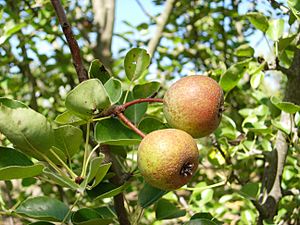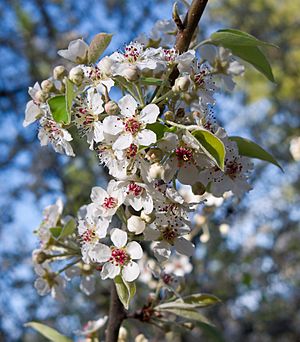Wild Himalayan pear facts for kids
Quick facts for kids Wild Himalayan pear |
|
|---|---|
 |
|
| Wild Himalayan pear tree with fruits | |
| Scientific classification | |
| Genus: |
Pyrus
|
| Species: |
pashia
|
The wild Himalayan pear, also known as Pyrus pashia, is a tree found in the Himalayas. It is a small to medium-sized tree. It has an oval-shaped top, leaves with tiny teeth, and pretty white flowers. These flowers have red parts inside. The tree also grows small fruits that look like pears.
This tree is native to southern Asia. People in different places call it by many names. Some names include batangi (in Urdu), tangi (in Kashmiri), mahal mol (in Hindi), and passi (in Nepal).
Contents
- Where the Wild Himalayan Pear Grows
- Where the Tree Lives and How it Grows
- What the Wild Himalayan Pear Looks Like
- Flowers of the Tree
- About the Fruit
- What's Inside the Fruit (Nutrition)
- Seeds of the Fruit
- How the Tree Reproduces
- Flowering and Fruiting Seasons
- Uses of the Wild Himalayan Pear
- Images for kids
- See also
Where the Wild Himalayan Pear Grows
The wild Himalayan pear tree grows across the Himalayas. You can find it from Pakistan all the way to Vietnam. It also grows from the southern parts of China to northern India. This tree is also found in Kashmir, Iran, and Afghanistan.
Where the Tree Lives and How it Grows
The wild Himalayan pear is a tough tree. It likes sandy soil that drains water well. It can grow in places that get 750 to 1500 millimeters of rain each year. It can also handle temperatures from -10 to 35 degrees Celsius.
What the Wild Himalayan Pear Looks Like
This tree usually grows in hilly areas. You can find it between 750 and 2600 meters (about 2,460 to 8,530 feet) above sea level. Most wild Himalayan pear trees are 6 to 10 meters (about 20 to 33 feet) tall. They can be about 6 meters (about 20 feet) wide.
Young trees have fuzzy leaves and branches. As the tree gets older, these parts become smoother. The leaves on a grown tree are simple and shiny. They are 5 to 10 centimeters (about 2 to 4 inches) long. They have a pointed oval shape and small teeth along the edges.
Older trees can have spiky branches. Their bark is rough and very dark, sometimes almost black. This dark bark makes the bright white flowers in spring look even more amazing. In autumn, the leaves turn a bright yellow color.
Flowers of the Tree
The flowers of the wild Himalayan pear are white. They sometimes have a little pink color. Each flower is about 2 to 5 centimeters (about 1 to 2 inches) wide. They grow in groups of 3 to 11 flowers.
Each flower has 5 sepals (small leaf-like parts) and 5 petals. It also has 15 to 20 red stamens. These are the parts that make pollen. The flowers have an ovary with 3 to 5 sections. Each section holds 2 ovules, which can become seeds.
About the Fruit
The wild Himalayan pear tree grows edible fruits. These fruits are called pome fruits, like apples. When they are ripe, they taste sweet, but can also be a bit tart.
Young fruits are light green. As they ripen, they turn a blackish-brown color. They have many yellow and white dots on their skin. The fruit can be round, oval, or pear-shaped. On average, the fruit is 1 to 4 centimeters (about 0.4 to 1.6 inches) wide. It is about 2 to 5 centimeters (about 0.8 to 2 inches) tall.
The fruit is best to eat when it is slightly soft, almost decaying. It has a grittier texture than other pears. When fully ripe and softened, it tastes sweet and pleasant. The fruits take a long time to ripen, from May to December. A mature tree can produce about 45 kilograms (about 99 pounds) of fruit each year.
You usually won't find these fruits in stores. This is because the tree is not grown much. Also, the ripe fruits are very soft and spoil quickly.
What's Inside the Fruit (Nutrition)
The fruit of the wild Himalayan pear has some good things in it. About 6.8% of the fruit is sugar. It also has 3.7% protein and 0.4% pectin. It has a small amount of Vitamin C, about 1.2 milligrams per 100 grams.
The fruit also contains minerals like phosphorus, potassium, calcium, magnesium, and iron.
Seeds of the Fruit
Each fruit usually has about five black seeds. They are small and light, often shaped like a pear. They are about 7 millimeters (about 0.3 inches) long and 2.5 millimeters (about 0.1 inches) wide. Each seed weighs about 21 milligrams.
How the Tree Reproduces
The wild Himalayan pear tree can reproduce in two ways. It can grow from seeds (sexual reproduction). It can also grow from parts of the plant, like roots or branches (vegetative reproduction). Seeds can stay good for 2 to 3 years if kept cold.
Flowering and Fruiting Seasons
The wild Himalayan pear flowers from late February to April. The fruits start to ripen in the first week of November. They continue to ripen until the last week of December.
Uses of the Wild Himalayan Pear
Food Uses
Local people eat the fruits of the wild Himalayan pear.
Medicinal Uses
Some local people use the juice from ripe fruits to help animals with conjunctivitis (an eye infection). They put the juice in the animal's eye. They also use about 6 teaspoons of this juice twice a day to treat diarrhea.
Other Uses
The wood of this tree is hard, heavy, and strong. It is light reddish-brown. People use the wood for fuel (to burn). They also make farm tools, walking sticks, and combs from it. Large branches are used for fencing. The tree's roots can be used for grafting other plants. The decayed fruits, leaves, and twigs are also used as food for animals. This tree can also help stop soil from washing away on steep hills.
Images for kids
See also
 In Spanish: Peral del Himalaya para niños
In Spanish: Peral del Himalaya para niños



